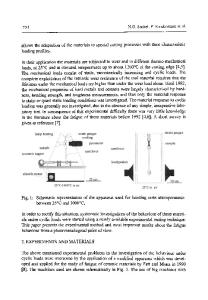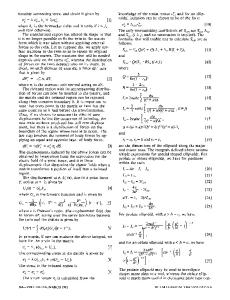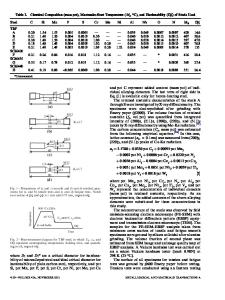Fatigue stress concentration and notch sensitivity in nanocrystalline metals
- PDF / 682,272 Bytes
- 13 Pages / 584.957 x 782.986 pts Page_size
- 8 Downloads / 426 Views
John A. Sharon Materials Science & Engineering, Sandia National Laboratories, Albuquerque, New Mexico 87185, USA; and currently employed at United Technologies Research Center, Hartford, Connecticut 06118, USA
Christopher J. O’Brien and Blythe G. Clark Materials Science & Engineering, Sandia National Laboratories, Albuquerque, New Mexico 87185, USA
Christian L. Arrington and Jamin R. Pillars Microsystems Science, Technology & Components, Sandia National Laboratories, Albuquerque, New Mexico 87185, USA (Received 11 August 2015; accepted 2 February 2016)
Recent studies have shown the potential for nanocrystalline metals to possess excellent fatigue resistance compared to their coarse-grained counterparts. Although the mechanical properties of nanocrystalline metals are believed to be particularly susceptible to material defects, a systematic study of the effects of geometric discontinuities on their fatigue performance has not yet been performed. In the present work, nanocrystalline Ni–40 wt%Fe containing both intrinsic and extrinsic defects were tested in tension–tension fatigue. The defects were found to dramatically reduce the fatigue resistance, which was attributed to the relatively high notch sensitivity in the nanocrystalline material. Microstructural analysis within the crack-initiation zones underneath the defects revealed cyclically-induced abnormal grain growth (AGG) as a predominant deformation and crack initiation mechanism during high-cycle fatigue. The onset of AGG and the ensuing fracture is likely accelerated by the stress concentrations, resulting in the reduced fatigue resistance compared to the relatively defect-free counterparts.
I. INTRODUCTION
While much attention in recent literature has focused on the enhanced strength and hardness of nanocrystalline (NC) metals, far fewer publications have been dedicated to their fatigue behaviors.1 From the few studies available, clear trends of improved high-cycle fatigue performance compared to coarse-grained (CG) and ultrafine grained (UFG) counterparts have emerged. For example, enhanced highcycle fatigue resistance has been observed in NC Ni,1–4 Ni alloys,5 Al,6 Ti,7 Co,3 and Cu.8 For these materials to be reliable, it is critical to understand the effects of notches, flaws, and geometric discontinuities on their fatigue performance, especially since NC metals can be particularly susceptible to processing-related flaws (e.g., pores, inclusions, and surface roughness),9,10 which are suspected to compromise their mechanical properties.10–12 The stress concentrating effect of a notch is often considered analytically from the perspective of continuum elasticity solutions where there is no material length Contributing Editor: Yang-T. Cheng a) Address all correspondence to this author. e-mail: [email protected] DOI: 10.1557/jmr.2016.66 740
http://journals.cambridge.org
scale.13 Even within the framework of purely elastic behavior, the presence of grains introduces a field of anisotropic domains that give rise to local stress and strain heterogeneities su
Data Loading...











